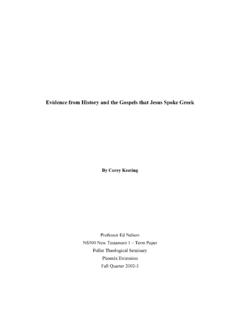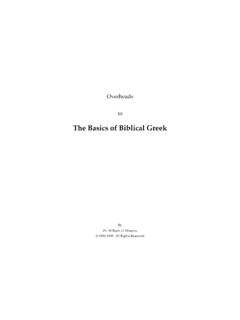Transcription of Baptism and the Lord’s Supper: A Theological …
1 Baptism and the Lord s Supper: A Theological position Statement By Corey Keating Professor Al Glenn ST503 Systematic Theology III Theological position Statement Fuller Theological Seminary, Phoenix Extension Spring Quarter 2002 Introduction In this paper I will explain my understanding of the Christian ordinances, or sacraments, of water Baptism and the Lord s Supper. I understand these ordinances in the way that most Protestant Christians would, namely that they are not a means of conveying grace, but visible signs of the invisible love of God shown in Christ Jesus, conveyed to us by the Holy Spirit. They are actions performed by Christians, not only in obedience to the command of the Lord Jesus, but as testimonies to faith in him. In this paper I will show the meaning and significance of these ordinances in the life of a Christian.
2 Baptism Water Baptism is a practice of the Christian Church that was instituted by the Lord Jesus himself. The last words of Jesus recorded in the book of Matthew contain the resurrected Lord s commandment to his disciples that they were to, Go therefore and make disciples of all nations, baptizing them in the name of the Father and of the Son and of the Holy Spirit, and teaching them to obey everything that I have commanded you (Matt 28:19-20).1 Jesus himself was baptized at the beginning of his earthly ministry (Matt 3:13-17). Since Baptism was commanded by the Lord Jesus, it has been practiced from the earliest recorded history of the Christian Church ( Acts 2:38). In the New testament , the normal pattern for Baptism was that it was performed immediately following faith in the Lord Jesus and repentance from sins. There are many instances in the New testament that show this pattern, especially in the Book of Acts.
3 In recording Philip s preaching of the gospel in Samaria, Acts 8:12 says, But when they believed 1 Unless otherwise noted, the scripture verses contained herein are from the New Revised Standard Version Bible, copyright 1989 by the Division of Christian Education of the National Council of the Churches of Christ in the , and are used by permission. All rights reserved. Page 2 Philip, who was proclaiming the good news about the kingdom of God and the name of Jesus Christ, they were baptized, both men and women. (Cf. Acts 2:41; 18:8). Thus Baptism is considered to be an outward act, showing a person s belief in the person and work of the Lord Jesus. Since Baptism is an act that follows belief in the Lord Jesus, the practice of baptizing infants is not introduced in the New testament and does not properly portray the reality that Baptism represents.
4 The New testament portrays John the Baptist s ministry of repentance as a precursor of Jesus ministry (cf. Matt 3:3-11), thus linking repentance to faith. Having faith in Christ should properly be connected with a person s repenting from their sins and turning from their old manner of life. Thus in Peter s first gospel message in Acts 2:38, he ties together repentance and Baptism by telling his listeners Repent, and be baptized every one of you in the name of Jesus Christ so that your sins may be forgiven. Being an act associated with entry into the Christian faith, properly speaking a person should only be baptized once during the course of their life. It is also worth mentioning that although the New testament does not describe the mode of Baptism in much detail, the practice seems to have been some sort of immersion into water as apposed to sprinkling water upon a person as they stood on dry land.
5 The basic meaning of the Greek word for baptize (baptivzw) is to dip or to immerse .2 Water Baptism is often described with the phrase baptized in water or baptized into water (cf. Matt 3:6,11; Mark 1:8,9; John 1:26). Acts 8:38 clearly states that Philip and the eunuch went down into the water, and Philip baptized him. 2 W. Bauer, A Greek-English Lexicon of the New testament and Early Christian Literature, trans. and adapted by Arndt and Gingrich, second edition ed. by F. Danker (Chicago, 1979). Page 3 The Meaning and Significance of Baptism The event of Baptism marks the beginning of the Christian s participation in the life, death, and resurrection of Christ. It signals one s death to an old way of life and one s birth to a new life in Christ. 3 We enter into this union with Christ by faith (Eph 2:8).
6 Our Baptism is an outward sign of the choice that we have made and a public testimony to the new life we have chosen. The New testament talks about the significance of this act in a number of different ways. In Romans 6, verses 3-5, Paul shows that Baptism symbolizes our death, burial, and resurrection with Christ. Many other verses talk about our dying with Christ to the world and to sin (cf. Gal 2:20; 6:14; Col 3:3), but it is in Romans that Baptism is revealed as an outward symbol of that inward reality. This passage goes on to reveal the practical significance testified to by our Baptism , that if we have died with Christ we are no longer enslaved to sin and its corresponding lusts. We should instead live as those who have been resurrected, presenting ourselves to God for the working of his righteousness (verses 6-13). Contrary to the teaching of some Christian groups, I do not believe that the Bible teaches baptismal regeneration.
7 This doctrine conveys the idea that Baptism is the instrumental cause of regeneration, and that the grace of regeneration is effectually conveyed through the administration of that rite wherever duly performed. 4 As stated above, forgiveness of sins and regeneration is connected with faith in the saving work of the Lord Jesus; Baptism is an outward sign of that inward reality. If Baptism was the means for regeneration and thus necessary for salvation, surely the Apostle Paul would not have made the point to say, For Christ did not send me to baptize but to proclaim the gospel (1 Cor 1:17). If Baptism was critically necessary to 3 Daniel L. Migliore, Faith Seeking Understanding: An Introduction to Christian Theology, (Grand Rapids: William B. Eerdmans Publishing Company, 1991) 215. 4 International Standard Bible Encyclopedia, Electronic Database Copyright (c)1996 by Biblesoft.
8 Page 4 accomplish the regenerating work in the life of a believer, then Paul would have been leaving the work of bringing salvation only half done. Lord s Supper Like Baptism , the Lord s Supper is also a practice of the Christian Church that was instituted by the Lord Jesus himself (cf. Matt 26:26-28; Mark 14:22-24; Luke 22:19-20). On the night before he was crucified, he gave his disciples an example of this symbolic meal and then instructed that they should continue to practice it (Luke 22:19). Unlike Baptism , which is associated with entry into the Christian faith and is only experienced once by a believer, the Lord s Supper is a practice that is enacted at regular intervals throughout a Christian s life. The mode or outward details of the Lord s Supper is not specifically mentioned in the Bible; all we know is that it took place in context of a meal (Matt 26:26).
9 Neither are we instructed as to how often we should practice this rite. Paul refers to the interval in the terms as often as (1 Cor 11:26), not giving a specific interval or how often it should be done. The Meaning and Significance of the Lord s Supper The practice of the Lord s Supper is filled with rich meaning and has significant implications for the Christian life. When the Lord first performed this symbolic meal, he indicated its significance in a number of ways. First of all, he broke the bread and gave it to them, saying, This is my body, which is given for you (Luke 22:19). By breaking the bread, he was indicating that his body was going to be broken for them in his crucifixion. He then gave them the cup of wine, which represented his blood. Not only was his body going to be broken, but also his blood was being poured out for you (Luke 22:20).
10 His crucifixion with the pouring out of his blood would initiate the new covenant and would produce the forgiveness of our sins (Matt 26:28). Page 5 Jesus instructed that we should do this in remembrance of him (Luke 22:19; 1 Cor 11:25). The Lord s Supper is a time that we should reflect on the love of the Lord Jesus that caused him to pour out his life for us in order to accomplish the forgiveness of our sins. In addition, 1 Corinthians 11:26 says as often as you eat this bread and drink the cup, you proclaim the Lord's death until he comes. Not only is this Supper a remembrance of the Lord s death, but it is also a declaration that he gave his life for us. Our partaking of the Lord s Supper is a sort of proclamation, an acting out of the good news of Christ s sacrifice on our behalf. Paul also mentions that we proclaim his death until he comes.








